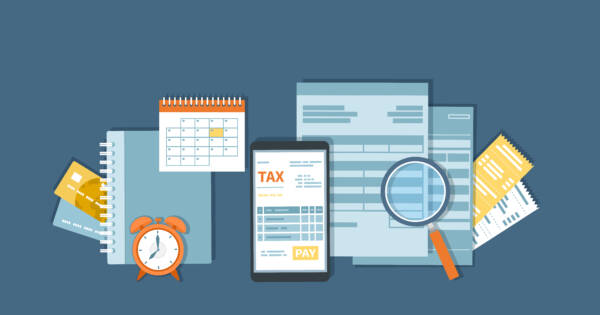Every single Spring, it’s the same thing. Tax season rolls around and millions of Americans stress about making sure their tax returns are correct. Even more than that, plenty of us search every nook and cranny of the tax code for ways to pay as little as possible. For most people, income tax returns are a complicated and annoying (yet necessary) part of our lives. One of the most common questions about tax returns related to tax credits. Specifically, we’ve seen plenty of you ask “What are Schedule 3 non-refundable credits?”
In short, a non-refundable tax credit is something that can reduce your tax liability (the amount of tax you owe). In some cases, it can reduce it to $0, or below. However, any amount that remains from the credit is automatically forfeited. A non-refundable tax credit is also referred to as a “wastable tax credit.” In other words, you can’t increase your refund by stacking non-refundable tax credits. Let’s take a deeper dive.
How Schedule 3 Non-Refundable Credits Work
The U.S. federal government provides certain tax breaks in the form of tax credits. They will help reduce the amount of tax you might owe. A tax credit is applied to the amount of tax owed, after any other deductions are made. Credits will reduce the total tax bill. For example, let’s say you owed $5,000 in taxes to the government. However, you’re eligible for a $2,000 tax credit. In the end, you would only have to pay a $3,000 tax bill.
Tax credits are generally more favorable than tax deductions. That’s because credits reduce your tax liability on a dollar-for-dollar basis. While a deduction still reduces the final amount of tax owed, they only do so within an individual’s marginal tax rate. While tax brackets can be a bit complicated, your marginal tax rate is the overall percentage of your income you owe in taxes. So someone with a marginal tax rate of 22% ends up paying $0.22 for every dollar they make. However, a tax credit can reduce that liability by full dollars.
What is a Schedule 3?
A Schedule 3 form is an auxiliary form that lists your non-refundable tax credits. It’s technically part of your Form 1040. It’s a single page form, which you can download from the IRS right here. You use it to list your various tax credit amounts. Just keep in mind that the IRS may ask you to attach proof, if the numbers seem fishy. Keep all the appropriate documentation associated with your tax credits. Otherwise, you might find yourself facing a full-blown tax audit.
Refundable vs. Non-Refundable Tax Credits
Tax credits are typically categorized as being either “refundable” or “non-refundable.” A refundable credit usually results in a refund check. That’s assuming the credit ends up being more than the amount of tax owed. A taxpayer who applies a $2,500 tax credit to their $2,000 tax bill will have the amount owing reduced to zero. The remaining $500 will be refunded directly to them in cash.
In contrast, a “non-refundable” tax credit does not result in a refund. It can only reduce your taxes owed down to $0, but no further. Following our previous example, let’s switch the $2,500 tax credit to being non-refundable. The taxpayer would still escape having a $2,000 tax bill. However, they would not receive the extra $500 in the form of a refund.
Types Of Non-Refundable Tax Credits
Simply put, non-refundable tax credits are good in that they reduce the amount of tax owed to Uncle Sam. On the other hand, they aren’t perfect, since they don’t result in a cash refund. Examples of common non-refundable tax credits include the following items.
- Saver’s Credit
- Lifetime Learning Credit
- Adoption Credit
- Child and Dependent Care Credit
- Foreign Tax Credit
- Mortgage Interest Tax Credit
- Elderly and Disabled Credit
- General Business Credit
- Alternative Motor Vehicle Credit
Some non-refundable tax credits, such as the general business credit and foreign tax credit, allow you to carry any unused amounts forward to future tax years. However, there are time limits applied to these carryover rules. For example, unused portions of the General Business Credit may be carried forward up to 20 years. However, you can only carry over the Foreign Tax Credit forward up to 10 years.
Pros and Cons of Schedule 3 Non-Refundable Credits
When it comes to tax credits, you should use the non-refundable ones first. They will help minimize (or eliminate) your potential taxes owing. After you’ve used your eligible non-refundable credits, go ahead and apply any refundable credits you qualify for. If the total amount of tax owed falls below zero, you are likely to receive a cash refund. However, if refundable tax credits are used first and non-refundable ones second, then the tax owed might still be reduced to zero — but no refund will be issued.
It’s important to remember that non-refundable tax credits are only valid for one year — the current tax filing year. In most cases, non-refundable credits expire once a tax return is filed. In general, they may not be carried over into future years (with a few exceptions). While it’s always important to use non-refundable tax credits, you will want to maximize their benefits. Consulting with a certified tax professional can help ensure that you use these credits as effectively as possible.
The Bottom Line
Non-refundable credits can be a bit of a double-edged sword. On one hand, they will definitely help lower your potential tax liability. It’s possible they can be used to reduce it to $0, actually. That’s great, since literally no one enjoys paying taxes. However, they also don’t do anything to bump up your potential tax refund. If you’re someone who looks forward to an extra influx of cash every Spring, non-refundable credits won’t add anything to your pockets.
Of course, we could make the argument that getting a tax refund is actually a bad thing. It means, essentially, that you’ve given the government an interest free loan in the amount of your refund. Or in other words, that you paid too much of your own money in taxes over the last 12 months. Plenty of financial experts insist you’re better off trying to keep your refund as close to $0 as possible. Then take that extra money and invest it throughout the year. You’ll end up with more in the long run.
 Shutterstock
Shutterstock







